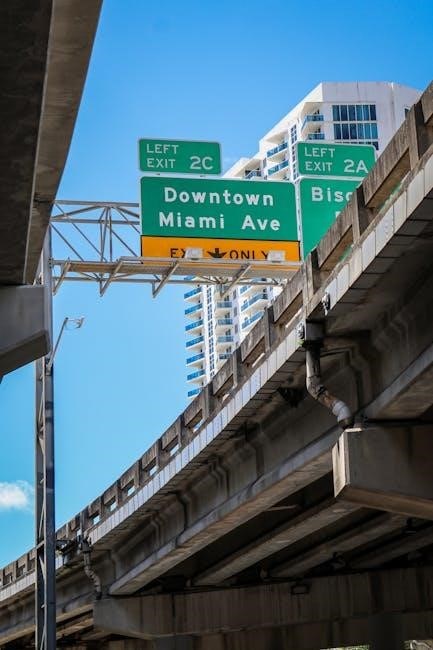Navigating Florida’s roads requires a solid grasp of traffic signs. The Florida Drivers Handbook is a crucial resource, providing detailed information on various road signs, their meanings, and importance. Studying this guide will help you pass the DMV exam and become a safe driver.
Official Florida Driver License Handbook
The Official Florida Driver License Handbook, published by the Florida Department of Highway Safety and Motor Vehicles (FLHSMV), is an indispensable resource for anyone seeking to obtain a driver’s license in Florida. This comprehensive guide contains essential information about Florida’s traffic laws, safe driving practices, and, most importantly, road signs. A thorough understanding of the handbook is crucial for passing the Florida DMV exam, which tests your knowledge of road rules and signs. The handbook covers a variety of topics, including traffic signals, pavement markings, and specialized signs.
By studying the handbook diligently, you’ll gain the knowledge and skills necessary to navigate Florida’s roadways safely and confidently. The handbook also provides valuable insights into defensive driving techniques and strategies for avoiding accidents. In addition to the handbook, consider taking practice tests to reinforce your understanding of the material. Many online resources offer free Florida practice tests that simulate the actual DMV exam. Combining your study of the handbook with practice tests will significantly increase your chances of success on the exam.

Accessing the Florida Drivers Handbook
Obtaining the Florida Drivers Handbook is a straightforward process, ensuring that all prospective drivers have access to this vital resource. The handbook is readily available through several channels, making it convenient for individuals to study and prepare for their driving exams. One of the easiest ways to access the handbook is through the Florida Department of Highway Safety and Motor Vehicles (FLHSMV) website. The FLHSMV website offers a free downloadable PDF version of the handbook, allowing you to view it on your computer, tablet, or smartphone.
Alternatively, physical copies of the handbook are often available at local driver’s license offices throughout Florida. These offices serve as distribution points, ensuring that residents can obtain a hard copy for offline study. Some driving schools and educational institutions may also provide the handbook to their students as part of their driver education programs. Regardless of the method you choose, ensure that you are accessing the most recent version of the handbook, as traffic laws and regulations may change over time. Reviewing the latest edition will help you stay up-to-date and prepared for your driving test.

Understanding Warning Signs
Warning signs are a critical component of Florida’s road signage system, designed to alert drivers to potential hazards or unusual conditions ahead. These signs, typically diamond-shaped with a yellow background, serve as an early warning system, giving drivers time to adjust their speed and driving behavior accordingly. Recognizing and understanding these signs is essential for safe driving.
Common warning signs include those indicating curves, intersections, pedestrian crossings, and changes in road conditions. For instance, a curved arrow warns of an upcoming bend in the road, while a sign depicting two intersecting lines indicates an approaching intersection. Other warning signs may alert drivers to slippery road surfaces, merging traffic, or the presence of animals.
When you encounter a warning sign, it’s crucial to reduce your speed, pay close attention to your surroundings, and be prepared to react to any potential hazards. The specific action required will depend on the nature of the warning, but in general, caution and vigilance are key. Familiarizing yourself with the various warning signs and their meanings is a crucial step in becoming a safe and responsible driver in Florida.
Regulatory Signs in Florida
Regulatory signs in Florida are the backbone of traffic law enforcement, dictating what drivers must or must not do on the roadways. Unlike warning signs that alert to potential hazards, regulatory signs directly instruct drivers on legal requirements, ensuring order and safety. These signs are typically rectangular, with a white background and black or red lettering, making them easily identifiable.
Common examples include speed limit signs, which specify the maximum legal speed for a given area, and stop signs, which mandate a complete halt before proceeding. Other regulatory signs cover a range of rules, such as no-parking zones, one-way streets, and turn restrictions. These signs are legally binding, and failure to comply can result in fines, penalties, or even license suspension.
Understanding regulatory signs is not just about avoiding legal trouble; it’s about maintaining a safe and predictable driving environment for everyone. By following the instructions on these signs, drivers contribute to the smooth flow of traffic and reduce the risk of accidents. Therefore, mastering the meanings of regulatory signs is a crucial step for all Florida drivers.
Guide Signs and Their Purpose
Guide signs serve as navigational aids, directing drivers to destinations, identifying routes, and providing information about services and points of interest. Unlike regulatory signs, which enforce rules, or warning signs, which alert to hazards, guide signs offer assistance and orientation. These signs come in various shapes, sizes, and colors, each conveying specific types of information.
Typically, guide signs are rectangular with green backgrounds and white lettering for highways and interstates, while blue signs indicate services like gas stations, restaurants, and lodging. Brown signs denote recreational areas and points of scenic interest. These signs help drivers stay on course, make informed decisions about where to stop, and discover attractions along their journey.
Understanding guide signs is essential for efficient and stress-free travel. By paying attention to these signs, drivers can avoid getting lost, find necessary services, and explore the diverse offerings of Florida. Whether navigating unfamiliar city streets or embarking on a cross-state road trip, guide signs are invaluable tools for every driver; They contribute significantly to a smoother, safer, and more enjoyable driving experience.
Traffic Signals and Their Meanings
Traffic signals are essential for regulating traffic flow and preventing collisions at intersections. They use a standardized color system to communicate instructions to drivers, pedestrians, and cyclists. Understanding these signals is paramount for safe navigation on Florida roads.
The most common traffic signal is the three-light system: red, yellow, and green. A red light indicates a complete stop is required before the marked stop line or crosswalk. A yellow light signifies that the signal is about to turn red, and drivers should proceed with caution, stopping if it is safe to do so. A green light means that drivers may proceed through the intersection, provided it is clear and safe.
In addition to the standard three-light system, there are also arrow signals, which direct traffic turning left or right. A green arrow allows drivers to turn in the direction indicated, while a red arrow prohibits turning. Flashing signals also exist, with a flashing yellow light indicating caution and a flashing red light requiring a complete stop before proceeding when safe. Always observe traffic signals carefully and obey their commands to ensure your safety and the safety of others.
Pavement Markings: Lines and Symbols
Pavement markings are an integral part of the road system, guiding drivers and maintaining order. These markings consist of lines, symbols, and words painted on the road surface, conveying important information. Understanding these markings is crucial for safe and lawful driving.
Lines, both solid and broken, are used to delineate lanes and indicate whether lane changes are permitted. A solid white line indicates that lane changes are discouraged, while a broken white line allows lane changes. Yellow lines separate traffic moving in opposite directions. A solid yellow line indicates that passing is prohibited, while a broken yellow line allows passing when safe. Double yellow lines, either solid or broken, indicate specific restrictions on passing.
Symbols, such as arrows, are used to direct traffic into specific lanes or indicate turning movements. Words, such as “STOP” or “YIELD,” are used to reinforce instructions given by signs or signals. Additionally, pavement markings may indicate the presence of bicycle lanes, pedestrian crossings, or other special areas. Always pay attention to pavement markings and follow their guidance to ensure safe and efficient travel.
Construction and Maintenance Signs (Orange Signs)
Orange signs are a common sight on Florida roads, indicating construction and maintenance zones; These signs alert drivers to potential hazards and changes in traffic patterns due to road work. It’s crucial to understand and obey these signs to ensure safety for both drivers and construction workers.
Most construction and maintenance signs are diamond-shaped and feature black symbols or text on an orange background. They warn of conditions like lane closures, detours, flaggers, and uneven surfaces. Common signs include “Road Work Ahead,” “Lane Closed,” and “Flagger Ahead.”

When approaching a construction zone, reduce your speed and be prepared to stop. Follow the instructions given by flaggers and pay close attention to temporary traffic signals. Be aware of workers and equipment near the roadway. Remember that fines for traffic violations are often doubled in construction zones. Exercise patience and drive cautiously to help prevent accidents and keep everyone safe. Always check the Florida Drivers Handbook for detailed explanations of specific construction and maintenance road signs.

School Zone Signs
School zone signs are vital for ensuring the safety of children near schools in Florida. These signs alert drivers to areas with increased pedestrian traffic and reduced speed limits. Recognizing and obeying school zone signs is crucial for preventing accidents and protecting young students.
The most common school zone sign is a pentagon shape, often with a picture of children walking. These signs may also include flashing lights to indicate when the reduced speed limit is in effect, typically during school hours. It’s essential to be aware of these times and adjust your speed accordingly.
When approaching a school zone, reduce your speed and be prepared to stop for pedestrians. Be extra cautious and watch for children crossing the street or walking along the sidewalk. Avoid distractions like cell phones and focus on the road. Remember that fines for speeding in school zones are often significantly higher. By paying attention to school zone signs and driving responsibly, you can help create a safer environment for children and contribute to a safer community. Always consult the Florida Drivers Handbook for detailed information on road signs and school zone regulations.
Preparing for the Florida DMV Exam
The Florida DMV exam is a crucial step in obtaining your driver’s license, and thorough preparation is key to success. Start by carefully studying the Official Florida Driver License Handbook, which covers road rules, road signs, and safe driving practices. Pay close attention to the sections on traffic laws, speed limits, and right-of-way rules. Understanding these concepts is essential for both the written exam and safe driving.
Focus on the chapter about traffic signs in particular. Familiarize yourself with the different shapes, colors, and meanings of various signs, including warning signs, regulatory signs, and guide signs. Practice identifying these signs and understanding their implications for drivers. Utilize online resources like free Florida practice tests to reinforce your knowledge and identify areas where you need further study.
Consider taking a Florida drivers ed course for a more comprehensive learning experience. These courses often include interactive lessons, quizzes, and simulated exams. Remember that the DMV exam tests your knowledge of both theoretical concepts and practical driving skills. By combining thorough study of the handbook with practice tests and potentially a driver’s education course, you can increase your chances of passing the DMV exam and becoming a safe and responsible driver.
